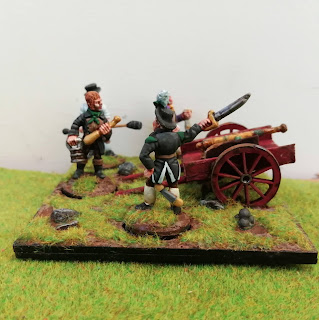I've been busy working on some more artillery crews- here are the results!
The first piece is a rebel-crewed howitzer. At the Battle of Three Rocks, a British relief column, sent from Duncan on Fort to reinforce Wexford Town, was ambushed. This column included two howitzers, which, along with their gunners, were captured. According to Pakenham, both the howitzers and the captured artillerymen were used by the rebels at New Ross. One prisoner, suspected of deliberately missing the British Militia, is said to have remarked "Isn't that a fine shot?" as he blew away a chimney. A rebel responded "it is; but this will be a better one" before shooting the prisoner dead.
This model is actually a French Gribeauval howitzer, as Trent Miniatures don't produce a British one.
This crew is commanded by Esmond Kyan. Although a member of the gentry, Kyan became involved in the Wexford Catholic Committee, and may have been one of the founders of the United Irishmen movement in Wexford. Kyan was a colonel of the United Irishmen.
He had previously fought in the British army, as part of the artillery; he might even have fought on the continent. As such his knowledge was useful to the rebel force. Kyan wore a prosthetic arm, having lost his right arm in a duel with a debtor. This prosthesis was torn off by a cannonball at the Battle of Arklow. Kyan is said to have shouted ‘My loose timbers are flying, God bless the mark . . . now for the right arm of the British line’ in response (according to Furlong's book on John Murphy).
He returned to Wexford Town to seek medical aid, and intervened to prevent sectarian murder there. Kyan marched to Wicklow with the rebels, but soon returned to Wexford. He was soon caught and executed.
This information comes from the book "Fr John Murphy 1753-1798" and
this website.
The above engraving is the only image I could use to paint this figure. I chose a model with the closest features I could. I assumed the light coloured hair in the image was blond, but have no idea if this is correct. The right arm was repositioned using a pliers.
This crew are from the Royal Irish Artillery. This regiment was founded in 1760 from an earlier Artillery Company ("The Uniforms of 1798-1803", F. Glenn Thompson). Furlong states 16 members of this regiment were captured at Three Rocks.
One of their guns (I think it's a 12 pounder) is on display at Collins Barracks, Dublin. Its undercarriage is painted black, but I believe it is a reconstruction. Thompson's book on the uniforms of the period states this regiment painted their cannons' carriages grey.
In other news, I'll be participating in this year's Analogue Hobbies Painting Challenge, which begins on December 21st. It's my first time taking part. I'm looking forward to it as I've been enjoying the great work of the Challenge participants for a few years now.
Best of luck to everyone involved!
Go dtí an chéad uair eile, beir bua!






























